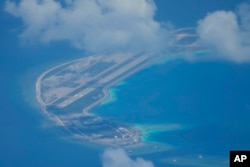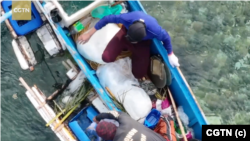On May 20, the Philippines called for an international investigation of the environmental damage in the South China Sea. Manila accused China of destroying the marine ecosystem, after the Philippine Coastal Guard shared a series of satellite images showing badly damaged coral reefs surrounding the Scarborough Shoal.
China denied the accusations, and reasserted claims to Philippine-administered Thitu Island, also known as Pag-asa Island or Zhongye Dao in China, in the Spratly Islands.
Chinese Foreign Ministry spokesperson Wang Wenbin said during a May 21 press briefing:
"The Philippines illegally occupied China's Zhongye Dao and has carried out frequent activities in the adjacent waters of Zhongye Dao. If any environmental degradation appears in those waters, it is the Philippines who needs to reflect on its behavior, instead of wrongly accusing China."
That is false.
The Permanent Court of Arbitration at the Hague did not recognize China’s claims over the Spratly Islands. China is the main polluter of the South China Sea where Beijing’s island-building, dredging and overfishing causes severe environmental damage.
Asia Maritime Transparency Initiative (AMTI), a project of the Center for Strategic and International Studies in Washington, determined that China had played the “largest role” in the “South China Sea’s declining marine environment.”
In an investigation released in December 2023, the AMTI exposed how Beijing’s actions contributed to the environmental degradation.
As part of efforts to assert its sweeping claims to the South China Sea, China has established a military presence on the Paracel and Spratly islands and created artificial islands.
The process of creating those artificial islands involves dredging the seafloor and pouring that seafloor material on top of coral reefs.
“This process disturbed the seafloor, creating clouds of abrasive sediment that killed nearby marine life and overwhelmed the coral reef’s capacity to repair itself,” the report found. “The results show that China has caused the most reef destruction through dredging and land fill, burying roughly 4,648 acres of reefs.”
The report says China’s overall damage to coral reefs in the South China Sea is more extensive.
With the help of commercial satellite imagery, AMTI determined that China had destroyed or seriously damaged “at least 21,183 acres of coral reef—and likely much more—through island expansion and giant clam harvesting.”
China challenged that, alleging the report authors cited “a few satellite images” and stirred up “falsified allegations from years ago” to come to conclusions that are “neither factual nor verifiable.”
However, international bodies, academics and others also say China has caused significant environmental harm to the sea.
In 2013, the Philippines filed a petition with the Permanent Court of Arbitration at the Hague. The Hague, contesting that China’s claims to the bulk of the South China Sea violated the Philippines’ rights to its exclusive economic zone (EEZ) — the 200-nautical mile stretch of sea from the coast of a state — and its territorial waters.
In its 2016 ruling, The Hague rebuked Beijing’s sweeping claims to the sea, and found that “China’s artificial island-building activities on the seven reefs in the Spratly Islands have caused devastating and long-lasting damage to the marine environment.”
The Hague said that “through its island-building activities in the South China Sea, Beijing had breached various articles of the United Nations Convention on the Law of the Sea, includes the states’ “obligations to protect and preserve the marine environment.”
The Hague found China “has conducted dredging in such a way as to pollute the marine environment with sediment in breach of Article 194(1) and has violated its duty under Article 194(5) to take measures necessary to protect and preserve rare or fragile ecosystems as well as the habitat of depleted, threatened or endangered species and other forms of marine life."
China’s “island-building represents the quickest deterioration of coral reefs in human history,” U.S. researchers, citing expert testimonies from the arbitration hearings, wrote in a 2019 paper published in the peer-reviewed journal Scientific Reports.
The AMTI also found that through industrial fishing, particularly the practice of bottom trawling, which involves dragging “large, weighted nets along the seabed,” China had contributed to destroying South China seabed ecosystems “by ripping up coral and sponges and stirring up sediment.”
China’s pernicious fishing practices extend beyond the South China Sea.
Chinese fishing vessels systematically engage in illegal fishing, particularly off the coast of South America, imperiling their ecosystems.
The Philippines also accused China of illegally building an artificial island in its EEZ.
In September 2023, Philippine coast guard spokesman Jay Tarriela said the Philippines armed forces had exposed “the severe damage” the Chinese forces “inflicted upon the marine environment and coral reef.”
Tarriela said a survey conducted on Sabina Shoal, known as Escoda Shoal in the Philippines, had "revealed visible discoloration of its seabed,” indicating China was attempting to “modify the natural topography of its underwater terrain” and making land from waterbody beds.
When asked about the island building claims, Wang Wenbin accused the Philippines of spreading rumors and vilifying China to “mislead the international community.”
To further deflect from these accusations, on May 13, China’s state-run English language news channel CGTN posted a video on X, showing what they identified as “Filipino fishermen.”
The video showed a fisherman spitting into the sea and another dropping something small into the water. CGTN accompanied the post with a comment reading: “Who are damaging the South China Sea? Here you go!”
It is misinformation of staggering proportions to compare the spitting fisherman to the damage that China’s dredging, island building, and overfishing is doing to the South China Sea.








